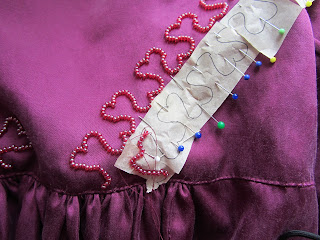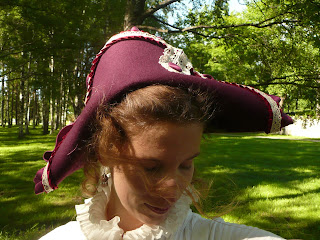I saw the the fabulous 1820s pelisse in the Museum of London last September and was instantly smitten. Here was a garment that needed to be reproduced! I begun the project in late February this year and now it's finished. In retrospect, it didn't really take that long; I had other projects in the making at the same time, so maybe if I had only been sewing the pelisse, it would've been ready earlier.
The coat pattern itself is not that complicated, I used my trusty Regency bodice pattern and took the hem pattern from Jean Hunnisett's book; it actually is the 1820s hem pattern, so the shape is very similar (at least to me) as with the original. I think I might have made the bodice a little bit longer, as the waistline begun to creep downwards again in the 1820s, but it works like it is, too.
I drafted the petal sleeves and the collar myself, and I'm especially pleased with how the collar turned out. It's so pretty! For the sleeves I used my standard Regency sleeve pattern and added the slightly flared cuffs.
The most time-consuming bit of the entire project was obviously all the trimming and the beading. I made the rouleaux piping out of the pelisse fabric; I just cut about 2,5cm wide strips of the cloth on the bias, sewed the short ends together and then machine stitched the long sides together. I then turned the tubes right side out and pinned and handsewed them on the pelisse. The coat is entirely handsewn, I only used the machine when I made the piping, because... well, it's pretty obvious why!
I drew the leaf motifs and the beading patterns on tissue paper and pinned them on the coat and then sewed the piping and the beads on. When I was finished I just ripped off the paper. This way, the piping and the beading came out very even and it was tons easier to manage the symmetry and the mirroring patterns on the front edges. I actually use the tissue paper trick pretty much always when I embroider, I find it works very well and I don't have to trace the patterns on the fabrics.
The pelisse has 140 grams of glass beads on it and - I would guess - about 30 metres of rouleaux piping.
Want to see what it looks like?
All outdoors pictures by Suvi Saraste, construction photos by me.
 |
| The pelisse and the belt have hooks and eyes closing |
 |
| The original pelisse had the leaf trimming on the shoulders as well but I chose to have just the two repeats of the pattern. |
 |
| I wore the fern dress underneath |
I also made a little bicorn hat to go with the coat. I made the massive red bonnet earlier, but somehow that doesn't look right with the pelisse. I might make a big turban hat later, those seem to be very popular in the 1820s fashion plates.
The bicorn came about when I was watching the 1995 Pride and Prejudice for the umpteenth time; I noticed that Mrs. Hurst (Mr. Bingley's married sister) wears a jaunty little bicorn whenever she's out and about. Inspiration! I had a couple of those floppy 70s-esque felt hats lying around, one black and one plum, I had bought them with 1 euro apiece and hadn't really done anything with them. But now!
I don't know how period accurate the bicorn really is, especially on ladies, but at least they were around at the time and soldiers and even civilian men wore them. And anyway, women's Regency fashion took a lot of influences from the military uniforms of the time. You could even say that the Museum of London pelisse has the sort of military cord trimming going on, only the cords have been arranged in nice, feminine leafy patterns.
There are some construction photos of the hat further down.
The hair was a problem, as ever. You'd think that Regency dos would be easy, but I think that nonchalant "I just whipped my hair up in a bun like this, and doesn't it look cool and simple and nicely curled" style is difficult to achieve. My hair is wavy and curls very easily, but making a nice bun with some pretty curls around my face just never works out the way I'd want. Meh. Got to keep on practicing.
So, how did I make the pelisse? Luckily, I did take a lot of photos.
 |
| Beading the back piece, I attached all the beads one by one. I found that that way the beading was more stabile and it was faster and easier than attaching a long string of beads. |
 |
| Attaching the rouleaux piping. Having the paper pattern really helped with the symmetry. |
 |
| I don't know how the piping was attached in the original pelisse but I chose to sew through the piping in tiny stitches. |
 |
| I also added a cord piping to the front edges to support them and keep them straight. |
 |
| After finishing the trimming and the beading I added facing pieces to cover up all the stitching on the inside of the coat. |
 |
| An extra piece added under the hooks and eyes to conceal any gaping between the front edges |
A couple of photos of the hat:
 |
| A floppy felt hat + trimming. |































Wow!!!! And DOUBLE WOW!!! This is amazingly beautiful!!! xxV
VastaaPoistaThank you! I'm very happy with it :)
PoistaThis is stunning! You did an amazing job on the pelisse - it's so beautiful and with such attention for detail! BRAVO!!!
VastaaPoistaAll the work with the piping is rewarded with a sublime garment. Everything matches perfectly and I love the white fern dress.
Now I'm back to scrolling up and done this blog post and enjoy the pictures once again :)
Sabine
Thank you very much for your kind words!
PoistaDear Nora,
Poistahere's a fantstic link to a pink LACMA dress (it's from late 1820s/early 1830s though), where you can see how the fabric was marked for applying decoration: http://lacma.wordpress.com/2010/05/06/faux-pearls-fish-scales-and-fancy-dress/
Sabine
Thanks for the link, Sabine! That's very interesting, it looks like they just took a pencil and drew on the fabric!
PoistaIt's gorgeous!!! Amazing details!
VastaaPoistaP.S. I've been dreaming about a regency ice skating party and some tea or hot chocolate afterwards for next winter, perhaps on January or February. Something small and informal. I don't know if this would be possible with so few in Finland with regency clothing (I haven't even started mine) and all of us scattered so far from each other, but I thought I'd mention this to you too if you'd be interested.
Thanks very much!
VastaaPoistaOooh, and ice skating party! Count me in! This past winter I took up skating again and it was so much fun (the last time I did it was at school :)! That would be a perfect opportunity for people to start making Regency clothes (*nudge nudge, wink wink*). I've also sometimes thought how much fun it'd be to have some kind of Regency event here in Finland too.
Kirjoittaja on poistanut tämän kommentin.
PoistaIt turned out to the prettiest dress you've ever made so far! The color is so perfect and the fabric looks even better in real life. I love the photos even though they never quite do justice to how it looks when you actually move. And that ice skating sounds so perfect. Inspired by it and by you Nora, I even started planning my regency undies today... :D Gotta create that regency wardrobe so I can go to Bath with you some day! ;)
VastaaPoistaHehee, I'm converting you to the Regency fashions, after all! :)
PoistaThe fabric really was a lovely find, I still don't know what exactly it is, maybe some cotton blend or something, but it was very nice to sew and it doesn't wrinkle that badly.
Wow! What magnificent work! I am really thrilled by your Pelisse! Simply wonderfully! Why I have not discovered your Blog before!? Well, now I will remain!
VastaaPoistaDear greetings,
Kerstin
Thank you very much! I'm glad you like the pelisse and that you found your way here :)
Poista-Noora-
Sabine linked me to your blog - absolutely amazing. So beautiful!
VastaaPoistaThank you!
PoistaI am in awe! the tracing paper is inspired!
VastaaPoistaThank you! The tracing paper trick saves the day each time :) I use it all the time for embroidery and the like.
PoistaBlogin hallinnoija on poistanut tämän kommentin.
VastaaPoistaGood heavens!! Here is it close up!! Your pelisse is so stunning!!! I am in love! All that glorious work you have done on it and your dress....so incredible!!! You have inspired me!!
VastaaPoistaBlessings!
Gina
Thank you very much! The pelisse was a lovely project and it still is my favourite piece of clothing I've ever made.
PoistaWhat an absolutely stunning pelisse! The detail and textures are exquisite! Its so much more elegant than the patterns I've seen for pelisses (I'd love to make one one day :) ). I need to think about making one from about ten or fifteen years earlier, but I was wondering if you'd mind me asking how much fabric you needed to make yours, just as a guideline? It really is the best one I've seen! Absolutely delicious detail. X
VastaaPoistaThank you very much! I think I originally bought maybe 4,5-5 metres of the fabric. The coat itself didn't really take up that much fabric, just the normal amount that e.g. a long sleeved Regency dress would need. The hem was a 1820s pattern, so it had a centre back piece, and slightly gored side and front pieces. Obviously the rouleaux piping was the reason I needed so much fabric; because it had to be cut on the bias I needed a bit extra.
PoistaI've also just realised we were at the events much of the time in Bath. :) You the wonderful harp player at Beckford's tower! I think we got the same lift back to town too. I hadn't realised you were in the fashion show, It was really great wasn't it? :) X
VastaaPoistaYou were at the tower? (*going over faces in my head*) :) Yes, I'm eternally grateful to Mike Parker for letting me play those harps, it really meant the world to me. I was in the fashion show, it was so much fun! I only wish that there were photos of the show somewhere.
VastaaPoistaThank you for the fabric quantities etc. I have a couple of photos of the fashion show. I'll let you know when I put them on facebook. x
VastaaPoistaThis is a tour de force. I'm so happy to see someone reproduce this, I've been itching to do one myself as I've been in love with the original for several years. I was doing research in the MoL's collection for my MA while they were preparing the Pleasure Garden display. I snuck a few pictures of it for myself before it was mounted, lol. You did an amazing job on your's and that colour is delicious. I salute you!
VastaaPoistaThank you very much! This is my favourite of all the things I've made. I actually got some photos of the original garment before it was put on display from the Museum of London; I emailed them asking about the construction of the coat and they sent me those photos! They were a big help :)
Poista